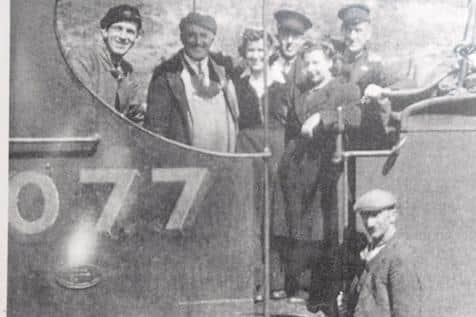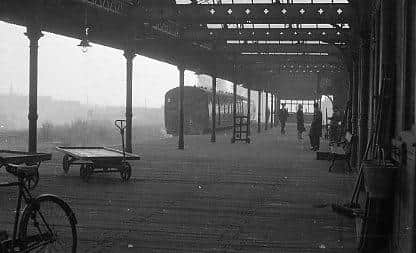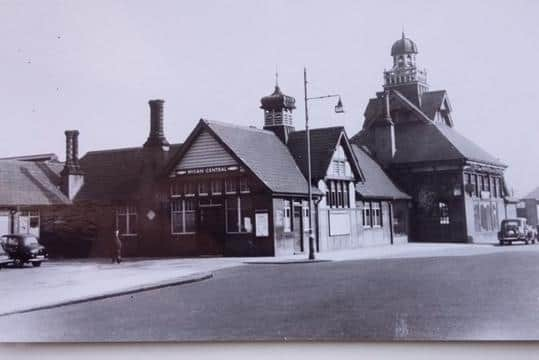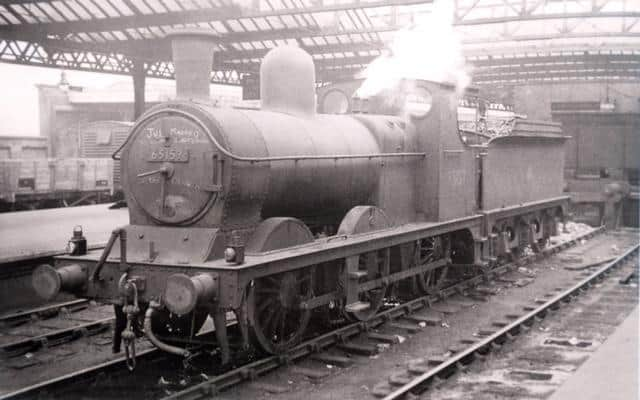Wigan Central Station: A new book is published about Wigan's 'forgotten third railway station' now buried under the Grand Arcade
and live on Freeview channel 276
Pub quiz champions though will know that for seven decades there were three.
And quirky-looking Wigan Central Station with its all-wooden platforms and chalet-style construction would survive the long-gone Great Central Railway Company and LNER operation.
Advertisement
Hide AdAdvertisement
Hide AdIt’s site is now long buried under the Grand Arcade shopping centre.


In fact it only finally succumbed to British Rail's rationalisation as late as 1964.
But a station is nothing without a ready supply of locomotives to pull those workmen’s and passenger trains to Manchester Central (now GMEX) via Bickershaw and Lowton St Mary’s.
Or indeed, St Helens Central, via the former Golborne, Haydock Park and Ashton-in-Makerfield stations.
Advertisement
Hide AdAdvertisement
Hide AdIn the Great Central's case it was – for almost 70 years until final closure in 1952 – Lower Ince Motive Power Depot … or “Shed,” to all railway folk.


Pictures are seeing light for the first time
Now Wigan enthusiast and railway historian Chris Coates brings this grimy, sooty, working hub of shunters, cleaners, fitters, drivers and firemen back to life from the clearly still much-missed twilight of steam days.
His new book, published by Steam Image, has taken well over six years of exhaustive research to compile and is the final effort in his trilogy of tributes to the loco sheds of Wigan.
It is packed with more than 270 prints with lengthy captions from the dawn of Lower Ince Shed's life, right up to the final workings which actually continue today on a truncated freight-only stub.


Advertisement
Hide AdAdvertisement
Hide AdIt is illustrated courtesy of photos by the council's retired former director of planning, John Sloane.
Amazingly, because the line was something of a poor relation to Wigan's other railways, many of these prints have lain undisturbed at the bottom of drawers.
The vast majority are only seeing light again for the first time, having never been published before.


For “pure” railway enthusiasts, who delight in poring over such detail, there are tables of the locos in the Great Central, LNER and BR periods of operation, visiting steam locos, a look at all stations, freight, excursion and workmen’s trains. Plus trip workings, pilot and shunt workings.
Advertisement
Hide AdAdvertisement
Hide AdAnd a poignant look at its final years of operation and its days of admittedly sparse services.
But where the book differs from so many railway studies is that author Mr Coates carefully paints pen pictures of the real-life characters based at Lower Ince Shed.
This absolutely brings it back to life 70 years after the last shovel of coal was swung into a gaping firebox.
The quirky characters and their stories
For example, the late Cyril Moran - who became a top class rugby league stand-off for Swinton after being spotted playing for St Pat’s - worked at the shed.


Advertisement
Hide AdAdvertisement
Hide AdBut Cyril found that, as his career progressed, it was proving more and more difficult to fit thrice-weekly training in with his loco-disposal duties.
Increasingly, colleagues would “cover for him” so that he could sneak off to Ince station on the former Lancashire and Yorkshire route for journeys to training.
On his return, the shed foreman - who clearly had growing suspicions - inquired of Cyril, “who that fellow, Moran, was” who was scoring freely for Swinton?
"Oh,'' said Cyril, without pausing for breath, "that was my cousin."
Advertisement
Hide AdAdvertisement
Hide AdIn fact many of his workmates would follow him at home games - resulting in a group of shed men perennially being "a wee bit late" for the start of the 5.30pm shift, having taken in the game.
Some of the locals neighbouring the shed used to wait until dark and then climb over the wall behind Britannia Bridge School and into the coal wagons in the sales yard to nick coal for their hearths.
Engine cleaners at the shed particularly hated this as it soon became common knowledge that the men doing the pinching were more often than not selling it door-to-door for “beer money”.
And shed bosses, noting the dwindling coal heap, often wrongly pointed the finger of suspicion at them.
Advertisement
Hide AdAdvertisement
Hide AdA group of cleaners decided to ambush the thieves and climbed to the top of the coal hoist, which filled the loco tenders.
They carried buckets of pebbles and showered the intruders as soon as they climbed into the wagons.
That led to plenty of dark glares from drinkers when the railwaymen went to The Rock pub nearby for a gill or two after shift – and met their tormentors from the other side of the bar.
Footplate men at the shed were issued with company clothing every two years consisting of overalls, cap and a coat.
Advertisement
Hide AdAdvertisement
Hide AdDuring the war years on the former GC when things were tight, a favoured alteration for these Reserved Occupation workers was to sew in a ''poacher’s pocket' which was ideal for stuffing surreptitiously with locomotive coal to keep those home fires burning.
Some drivers and firemen at Lower Ince were also infamous for appearing with voluminous “snap” baskets - but containing, on inspection, only comparatively frugal amounts of sandwiches and stewed brew tin tea for their break.
Actually they doubled - with judicious use of a tea towel to cover - as an ideal way of smuggling coal out of the shed confines as any!
Another story from those days includes that of a black pet dog which was adopted by enginemen and spent its days being stroked and petted at the shed.
Advertisement
Hide AdAdvertisement
Hide AdIt was only when the depot closed in 1952, following the withdrawal of services along the St Helens branch, that the truth was out.
Our canine companion was adopted by a railwayman.
But given a thorough bath as a condition of being allowed to enjoy future home comforts.
Stripped of the muck, oil and soot for the first time it was revealed to actually be, underneath the grime, white!
Recording railway history is serious challenge
Chris, a retired furniture salesman at long-gone high street chain Rumbelows, rejoices in being a life-long Wigan railway enthusiast.
Advertisement
Hide AdAdvertisement
Hide AdHe was, in the days of short trousers, a fanatical schoolboy “spotter”.
And he remembers being completely entranced watching Black Fives and BR Riddles Standard tanks rumble past Rylands Sidings on the WCML - not to forget the treat of the occasional “Lizzy” - all a quick pedal from his Gidlow home.
Latterly, as domestic funds increased and the pressures of family life eased, he started collecting semaphore signal blades and other historic railway memorabilia.
He owns the original Central Station running-in board now on public display at Wigan Central, bar under the railway arches
Advertisement
Hide AdAdvertisement
Hide AdAnd this would culminate in actually owning his own heritage mainline diesel engines, bought from BR as withdrawn scrap and then painstakingly restored by him and some pals.
These included a Class 25 and a Class 20, the freight engine which was such a familiar sight and sound hauling huge trains to powers stations from the Bickershaw Pit complex or neighbouring Parkside and Sutton Manor collieries.
He takes his responsibility in recording the borough's railway history as accurately as possible, immensely seriously.
And such dedication certainly wasn't without cost considering the number of times he made personal visits to the National Archives at Kew to research painstakingly the historic shareholders' annual reports from Directors of the Great Central Railway Company, eventually absorbed by he LNER and then, with nationalisation, becoming part of British Rail.
Advertisement
Hide AdAdvertisement
Hide AdHe also frequently searched the British Newspaper Archive to check - and double-check - key dates and times, including the forebears of this very title.
Chris said: "It has always been important to me to find out when things are actually done, rather than taking hearsay as fact or, with the best of intentions, just summising.
"All the detail in this book is absolutely as accurate as it is possible now to make it.
"I have been an enthusiast for all things railways for most of my conscious life, but that didn't mean I knew it all - far from it!
Advertisement
Hide AdAdvertisement
Hide Ad"It has taken six years’ hard graft, but then again I have gone out of my way to make sure things are correct.''
Chris spent many evenings enjoying a pint and a chat, long into the evening, with members of Wigan's retired railwaymen's association.
Author’s profound respect for railwaymen
He found their reminiscing a fascinating new source of genuinely hands-on information about its operation: Particularly the four retired surviving enginemen he tracked down, who had worked at the shed, including Bill Baxendale, a real font of operational knowledge and expertise.
And it left him with a profound admiration for the life of the professional Wigan railwayman, from drivers and firemen to shunters, cleaners and maintenance hands, in the steam days.
Advertisement
Hide AdAdvertisement
Hide AdHe says: "I was 12 when it closed and, sadly, I never took the chance to travel on the Great Central route from Wigan Central.
"When we did travel to Manchester, it was invariably the former Lancashire and Yorkshire Railway route from Wallgate Station or, on odd occasions, the LNWR route from North Western.
"It is now one of my greatest regrets.
"But working on the book has given me a profound respect for the railwaymen who worked out of Lower Ince Shed.
"It was a tough job that asked an awful lot of them for comparatively modest wages.
Advertisement
Hide AdAdvertisement
Hide Ad"Many were expected to be on-call, if not actually working, 24/7.
"A lot were required at Lower Ince shed to booking on at 2am and, with alarm clocks not to be trusted, these were the days of the professional knocker-up in Wigan, until surprisingly late in the day.
"They were regularly asking to be rostered for seven days non-stop just to make ends meet.
"Writing the story of the Wigan GC and and its shed, has shown me, again, that railwaymen of this time were a real breed out on their own, with so many unique characters.
"We won't see their likes again."
Advertisement
Hide AdAdvertisement
Hide AdThe Wigan Sheds - Volume Three , Lower Ince Motive Power Depot (£22.50) is available to buy at Wigan Central bar in the railway arches at North Western Station; Golden Days Garden Centre, Shevington; Wigan Market Newsagents.
